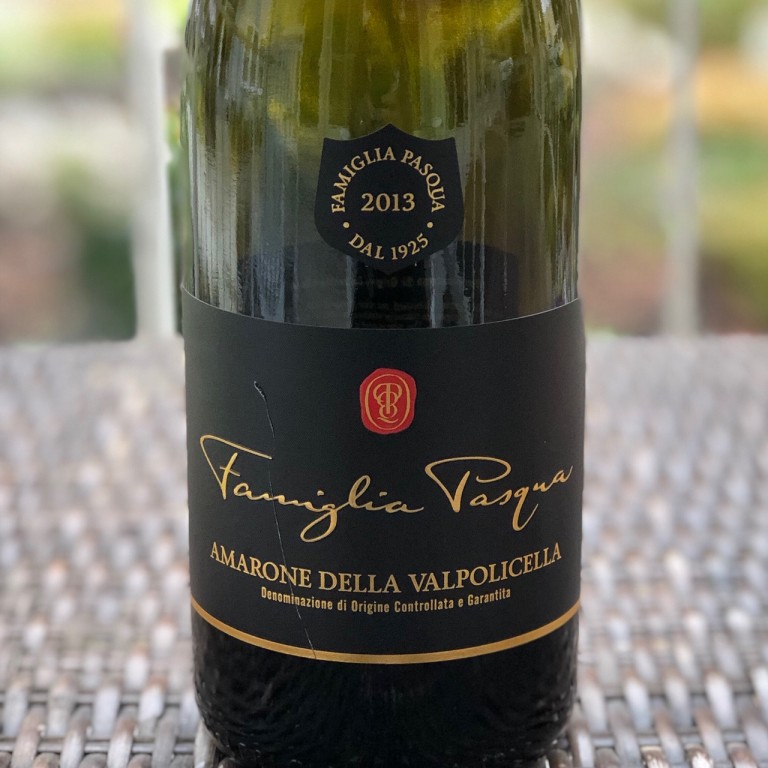This outstanding wine was a fantastic introduction to Amarone for me!
The grapes for this wine were hand-picked and sorted in late September, then left to wither in wood boxes (the appassimento process, meaning “withering” or “fading”) stored in a well-aerated loft for about three months, during which the fruit loses 25-30% in weight, resulting in greater density and concentration of flavor. The raisinated grapes are then crushed, ahead of a 25/30-day fermentation in temperature-controlled stainless-steel tanks. Continuous punch-down facilitates extraction of color and tannins. The finished wine is transferred to French oak barrels, where malolactic fermentation ensues, lending a softness to the wine. After 18-20 months of barrel-aging, the wine is bottled and left to rest, prior to release.
My tasting notes
Color – Crimson
Aromas – Black cherry, cassis, blackberry, petrichor, graham cracker, roast coffee and a whiff of cool mint
Body – Full and rich, but nicely balanced with medium-acidity and firm tannins
Taste – Black and red cherries, blackberry, light roast coffee, dark chocolate, licorice and savory spice
Finish – Long
A blend of 65% Corvina, 25% Rondinella, 5% Corvinone and 5% Negrara|ABV – 15%|SRP – $50|90pts
If you’re not familiar with Amarone (and I really wasn’t until recently), what chiefly defines an Amarone is the winemaking technique involved — appasimento, a drying of grapes to concentrate flavors. With appasimento, grapes are harvested by hand and left to dry, often on bamboo racks or straw mats, for 4-5 months, leading to a decrease in volume of 25% to 30%. Far more grapes are needed to make a glass of Amarone than is the case for wines produced from fresh grapes. Counterintuitively, the hand-picking is one of the costlier aspects of Amarone production: only bunches spaced sufficiently apart, featuring unblemished, bruise-free fruit, can be selected, to facilitate airflow and avoid rot during the dehydration period. No wonder Amarone is so prized and tends to be pricey!
This outstanding wine was a fantastic introduction to Amarone for me!
Pasqua Vigneti e Cantine is a historic winery that produces high quality Veneto and Italian wines and one of the main players in the Italian and international wine market.
The history of Pasqua Vigneti e Cantine begins in 1925, when the first generation of the Pasqua brothers came to Verona and established a new business devoted to the trade of wines from their homeland, Apulia. From wine trade and retail, they decided to become a real winery. In a few years, with the acquisition of new vineyards in the Verona area, the company progressively gained importance and visibility.
During the 60s, the second generation of the family entered the business, bringing about an opening to export and an orientation toward quality. The constitution of Cecilia Beretta in the 80s, the agricultural estate and innovative research centre for vines, grafting techniques and vineyards, is the symbol of the family’s constant quest for excellence.
In the mid 2000’s the company made a huge investment, testifying to the deep bond connecting the company and the family with the territory, with the creation of a new headquarters and manufacturing plant in San Felice, in the heart of the family vineyards.
When the third generation, composed by Riccardo, Alessandro, Cecilia and Giovanni, started to lead the company, the international market orientation boosted to a peak in 2009, with the foundation of Pasqua Usa LLC in New York. The company now sells wines in 50 countries worldwide.
________________________________________________________________________
Follow me on Twitter, Facebook, Instagram, and Vivino for all things vinous. As a wino with latent foodie tendencies, you’ll also find food and wine pairings. Become a fan and join ENOFYLZ Wine Blog on Facebook. Cheers!
Copyright Notice: This entire site is Copyrighted 2010-2019. All Rights Reserved. No unauthorized copying of any section of this site is permitted. If you wish to use any part of this site, contact me. For information on Copyright Law, see the official U.S. Copyright Office home page.


Love the description of the technique and makes you appreciate this wine even more!
Thanks Allison. Likewise it makes me appreciate Amarone more!
Great post 😁
Thanks so much for the kind words!